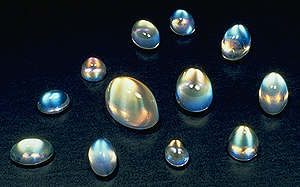Feldspars: Moonstones and Labradorite
The feldspars are a group of related minerals which, as a group are the most abundant minerals in the earth's crust. However, only a tiny percentage of the feldspars fall in the "gem quality" range. The members of the feldspar group have similar chemisty, but some have different crystal structures. Physical and optical properties are very similar.
3 Minute Read
The feldspars are a group of related minerals which, as a group are the most abundant minerals in the earth's crust. However, only a tiny percentage of the feldspars fall in the "gem quality" range. The members of the feldspar group have similar chemisty, but some have different crystal structures. Physical and optical properties are very similar.
Moonstones
Moonstones have phantoms of flash! As you turn the stone the flash of color, the mysterious sheen, moves around the gem, appearing and disappearing. Moonstones are orthoclase feldspar with a sheen called adularescence. The most elite of the moonstones have blue flash or a rainbow of colors. The body color of these moonstones are colorless and semi-transparent. Tiny platelets which are too small to see create the adularescence, reflecting back shimmering color. Some colorless moonstones have a white flash. Blue flash and rainbow moonstones have recently become very popular. Once considered plentiful, they are now rather scarce due to increased demand and prices have gone up. Nevertheless they are still in the low price category for small stones under a couple of carats. Exceptional quality large blue flash and rainbow moonstones will command per carat prices in the moderate price category.
| (Moonstone photo by ICA/Bart Curren) |
The blue flash moonstones are primarily found in Sri Lanka; the rainbow moonstones are from India. More abundant and less glamorous are pastel colored translucent moonstones from India; many of these have an eye, if the stones are cut to display chatoyancy. Colors available include peach tints, light greens, yellows, and medium to dark grays. These moonstones are mystical in their appearance and low in cost. Today moonstones are often carved into mini art works. Some are even carved with "man in the moon" faces. The cost of carvings may fall into the moderate category if they are very unusual.
Labradorite Gems
Labradorite, a mineral of the group, has many distinctive and exotic varieties which are considered gemstones. Rainbow moonstone is technically a labradorite variety.
Spectrolite
is dark translucent gemstone with an intense blue flash which is mined in Finland. Labradorite from Madagascar has minute black inclusions and a blue, green or golden flash. Heliolite is a variety mined in Oregon with a schiller effect that flashes out red, green, blue and orange; many of these have more than one color in each stone. This variety is generally faceted rather than cut into cabochons. Schiller is an almost metallic reflection created by minute inclusions in the stone. There are other varieties of labradorite such as colorless or light yellow transparent varieties; these lack an exciting appearance. Labradorite varieties generally run in the low price per carat range, but exceptional stones may demand more.
Amazonite
Amazonite is an opaque greenish blue variety of microcline feldspar. The finest amazonite is mined in Colorado but most commercial amazonite is mined in Brazil. This stone is in the low price range. If you are shopping for feldspar gemstones buy the gem that excites you. This mineral variety has phenomenal stones at a low price. If you like the unusual, a feldspar may be a good choice for you. When prices of the feldspar gemstones fall in the low range, the gems will not be heavily scrutinized to differentiate quality. There will be a wide range of stones with different personalities to choose from at the same price, so quality features are not as important an issue in this category except for the very finest stones. Of course, color and phenomena are the first considerations. Then examine the stones for any detracting flaws. Finally decide if the cut compliments the phenomenal aspects of the gemstone.
| Blue Moonstones (Photo by ICA/Bart Curren) |
| Colors: | Pastel tints of all colors |
| R.I.: | 1.51 - 1.59 Range for the whole group. |
| Durability: | Not very hard but they are reasonably tough |
| S.G.: | 2.54 - 2.70* |
| Treatment: | None known |
| Hardness: | 6 - 6 1/2 |
| Availability: | Supply meets present demand |
| Localities: | India, Madagascar, Labrador, Sri Lanka, Oregon |
| Price: | Mostly low, some moderate exceptions |
| Common shapes: | Cabochons: rounds and ovals |
You assume all responsibility and risk for the use of the safety resources available on or through this web page. The International Gem Society LLC does not assume any liability for the materials, information and opinions provided on, or available through, this web page. No advice or information provided by this website shall create any warranty. Reliance on such advice, information or the content of this web page is solely at your own risk, including without limitation any safety guidelines, resources or precautions, or any other information related to safety that may be available on or through this web page. The International Gem Society LLC disclaims any liability for injury, death or damages resulting from the use thereof.
The All-In-One Jewelry Making Solution At Your Fingertips
When you join the Ganoksin community, you get the tools you need to take your work to the next level.
Trusted Jewelry Making Information & Techniques
Sign up to receive the latest articles, techniques, and inspirations with our free newsletter.
